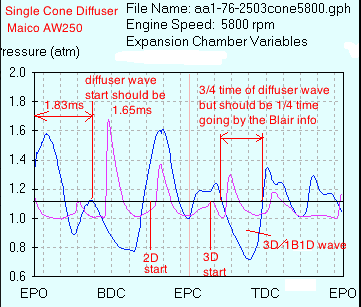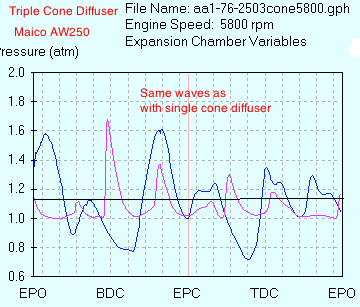|
How important is it to know the exhaust pulse width? Very important because it affects the durations of the return waves. The longer the exhaust pulse width (time), the longer the return waves. So if you have a bike with auxiliary exhaust ports but you want a wider powerband then you can plug the side ports with JBWeld which will lengthen the exhaust pulse and increase the time durations of the return waves which gives a broader powerband. What makes you think your system is good and trustworthy? Because mine emphasizes the synchronization of return wave timing with ports closing and takes into consideration the changes of wave speed in different sections of the pipe according to internal temperatures. Also it calculates return wave shape/height/time which is very important to know. And, of course, I have made numerous pipes and they all have given exceptional results. Are there any professional programs for simulating the return waves of an expansion chamber? Yes, there is EngMod2T for $400 and MOTA for $175. From a reliable source I heard that Frits Overmars and Jan Theil made pipes for Aprilia and ran the engines on a dyno and then input all the values and measurements into EngMod2T and the program was way off from the dyno output results. You can click here for another persons comparison between ECcalc and MOTA. I know a guy in Australia who races a kart with a KTM SX250 engine in it and he has his own dyno and makes his own pipes. He told me he built an optimized pipe designed by the Mota software and it didn't give him good power. A friend of mine put the Maico AW250 engine details into Mota with theoretical pipe details and gave me the same details to put into ECcalc to compare the two results. The Mota waves didn't change from single to triple cone diffuser. At least the diffuser wave should change but it didn't so Mota doesn't use the detailed wave generation method that I use, otherwise the wave peak would be more to the left with a single cone diffuser. ECcalc says the diffuser wave should start at 1.65ms using 564 degrees C mid header temp, and 1.7ms using 514 degrees (which is what ECcalc recommends) but Mota shows 1.83ms. Mota shows a high baffle wave peak but the contrary 2nd generation diffuser wave overlaps it which would lower the peak but Mota doesn't show that lowering. Blairs papers show that the secondary diffuser waves are 1/4 the time duration of the primary diffuser wave but Mota makes them 3/4 the time. My conclusion is that Mota is fancy software but they lack the precision that ECcalc has.   How does your calculator vary from Blairs formula for determining the tuned length of a pipe? Blairs and mine differ greatly but only because the speed of sound needed for his formula is the average pipe gas temperature, not the header gas temperature which is what most people enter into his formula. Most people don't even know that the temperature lessens the farther the gas is from the piston. I've measured all along the pipe and know this for a fact. My pipe calculator incorporates this fact into its formulas. As a result when people use the speed of sound with the header gas temperature in Blairs formula the outcome is almost 50% longer than what my calculator produces. Can a pipe be designed to make a high RPM engine have low RPM power? High RPM engines need both to have the ports lowered and to have a new design of pipe for a broader powerband at a lower RPM range. Why doesn't your program do all the calculations by itself and spit out the final design? It's possible in the future to be a bit more automated but the programming complexity required would be enormous to do everything. ECcalc is just a tool to be used by someone well informed on the subject of pipe design.
What type of sheet metal and type of welder do you
recommend? .7mm to 1mm thick plain steel (not stainless or
galvanized) and an oxyacetylene welder is best. Click here to read up if you want to buy your own
welder. How to use the welder: #1 #2 |